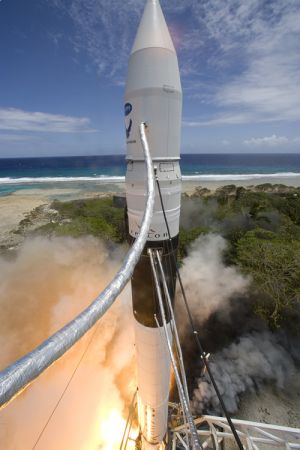The Falcon 1 spacecraft carried three satellites, including a NASA space shuttle, but a failure to separate the two stages prevented it from reaching orbit about two minutes after launch

A private spacecraft carrying three satellites, including a NASA space shuttle, failed to reach orbit. This is the third consecutive peace to launch Falcon 1, a satellite launcher built by the private company SpaceX. The system supposed to separate the stages two minutes and 20 seconds after the launch from the Kawajalein Islands in the Pacific Ocean did not work. SpaceX engineers are still investigating the cause of the malfunction.
"It is of course a big disappointment that we were not able to reach orbit on the third flight of Falcon 1," said Elon Musk, CEO of SpaceX in a statement to journalists. “The most important message I would like to commercialize right now is that SpaceX will not fail again. The fourth launcher is already ready and the fifth is in the final stages." Musk has so far invested millions of dollars of his own money, which he earned by selling two financial services companies. The company's goal is to develop a cheap launch system into space.
Falcon 1 carried inside it a tiny satellite built by the Pentagon - the Trail Blazer named after him, as well as a mini-laboratory called Para-Sat and a solar sail with a diameter of 10 square meters. These two satellites were built by NASA.
As mentioned, this is the third failure, after the first launch in March 2006 ended with the missile crashing due to a fuel leak and a fire caused by a rusty screw. During the second test in March 2007, the rocket reached an altitude of 290 kilometers above the Earth and almost achieved orbital speed, but the second stage was shut down too early due to mud in the fuel tank and control problems.
Last Saturday, the company launched a trial launch of the Falcon 9 rocket designed to transport cargo and astronauts to the International Space Station. The demonstration in Texas was able to meet the requirements of NASA, which provided the company with initial funding. NASA hopes that Falcon 9 can help fill the gap until the development of the spacecraft that will replace the shuttle is completed.
According to him, the company will continue to develop the launcher and overcome the incident thanks to a large investment made in it recently. "This investment and the cash advantage we also had before guarantee sufficient funding for the continuation of Falcon 1 launches and the development of Falcon 9 and Dragon. "I will never give up and I mean it," Musk said.

8 תגובות
Some freak must have caused it
Sometimes when the money is not the problem but the time it takes to develop a technology then download views swallow the pride and go with what is available
Can someone explain to me how it is that NASA invests so much money in a project that appears to be so unsuccessful (in a practical test in the field) and is even willing to fly with the help of this launcher a valuable satellite that has now become a pile of scrap?
What exactly are they going through there?
rust?
mud?
The last crash was probably caused by mouse droppings
Ha ha ha xD